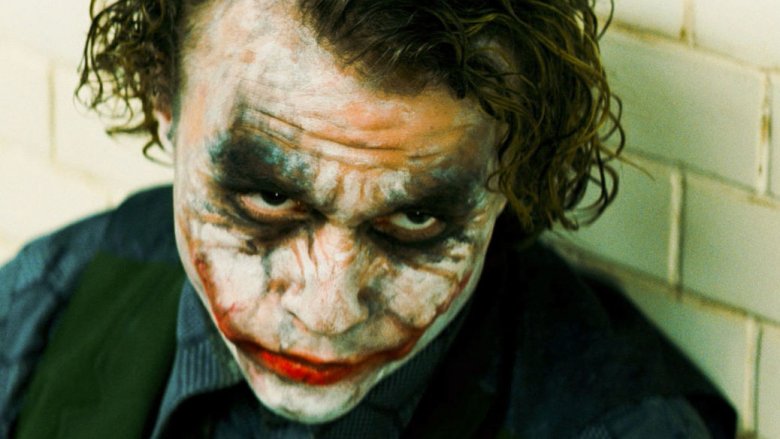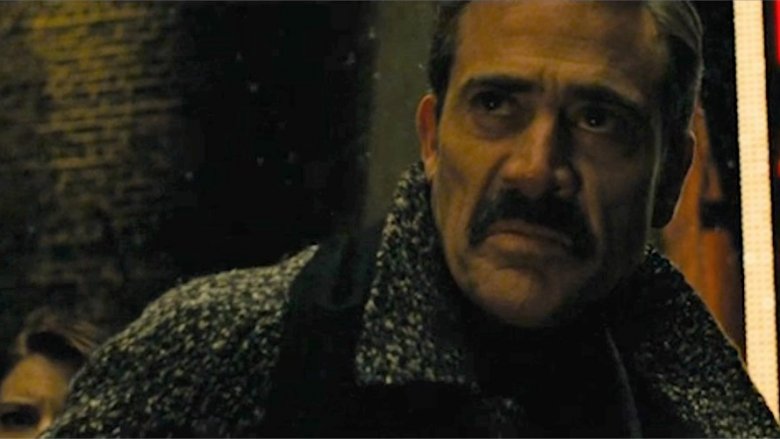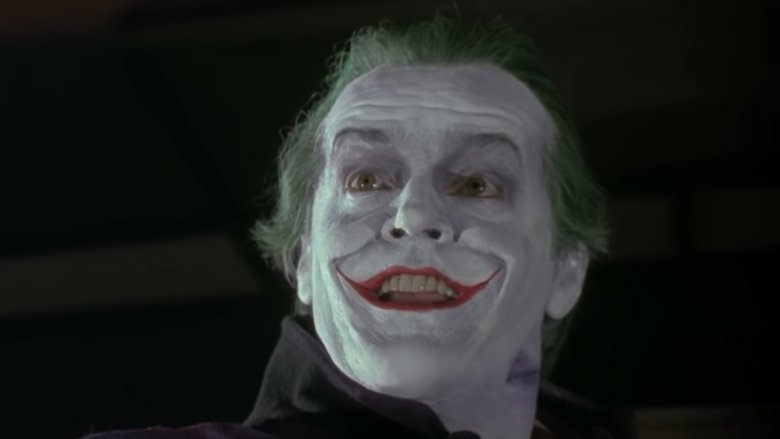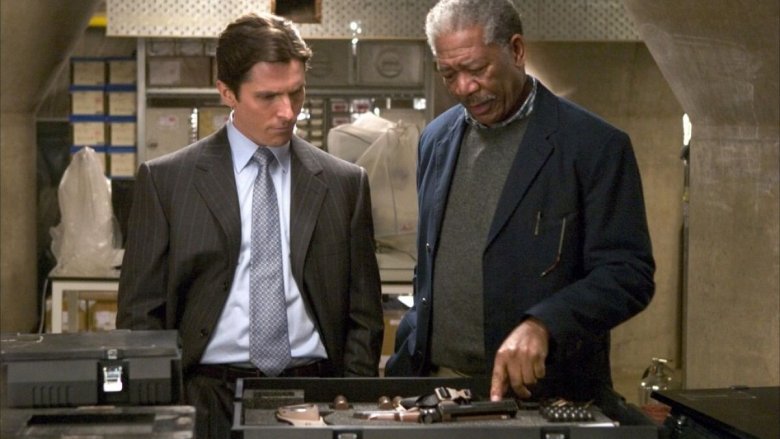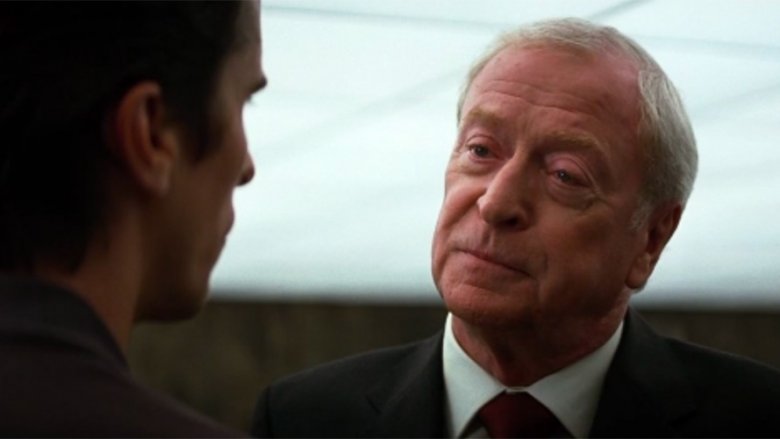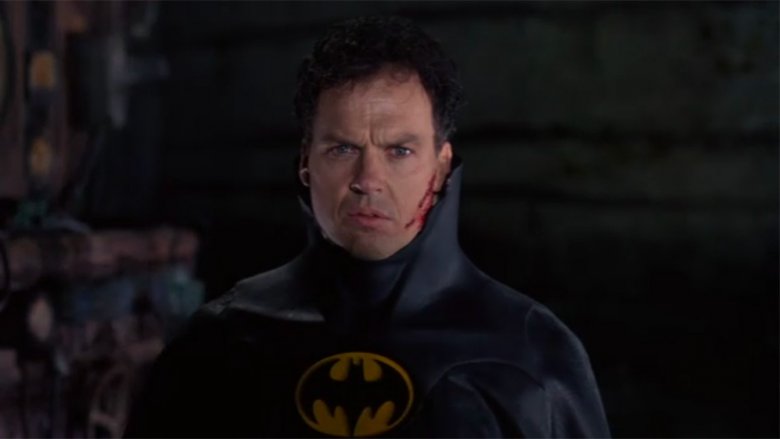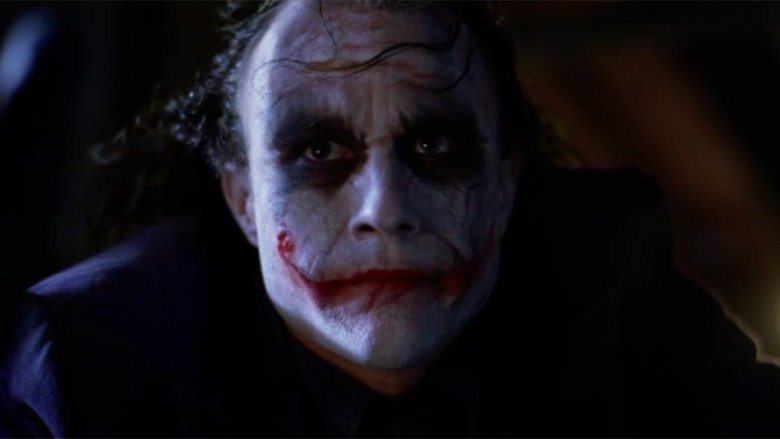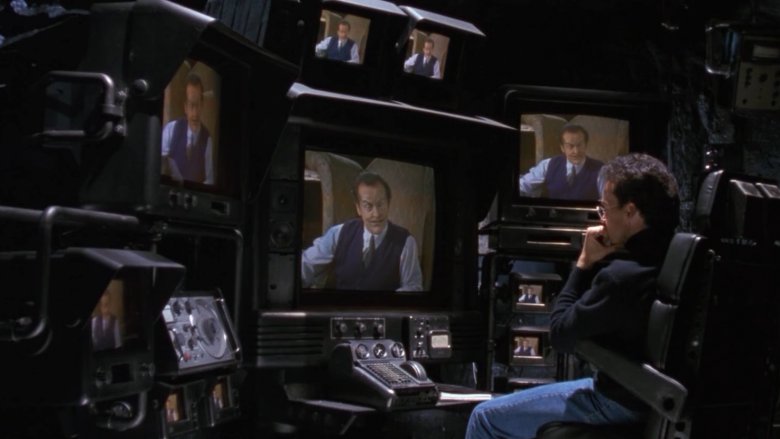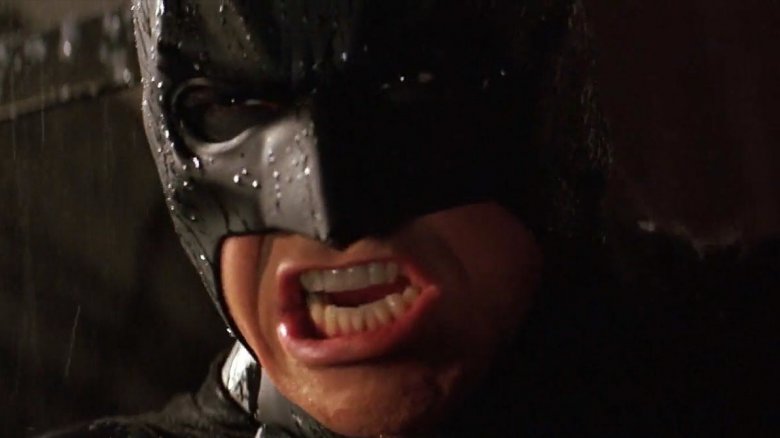These Things Happen In Every Single Batman Movie
Since his silver screen debut in 1943, Batman has been one of Hollywood's most prominent superheroes. He's starred in 11 theatrical features spread out across five vastly different versions of the character, from campy comedy to animated art-deco drama to dark, growling seriousness. Truly, there is a cinematic Batman out there for everyone... even people who want to see Ben Affleck do Crossfit.
But despite those vast differences, the Batmen we see on film are all drawing from the same well. Joel Schumacher's neon-soaked Gotham City, full of gigantic statues holding up highways, might be a far cry from Christopher Nolan's slightly grittier Chicago, but every Batman movie tends to pull the same handful of references and plot points again and again, to the point where you can pretty much set your bat-watch by them. From constant reminders that his parents are dead to flimsy excuses for dressing up like a bat, here are the things that feel like they happen in every single Batman movie.
Why do you think they call it Crime Alley?
Hey, did you know Batman's parents were shot by a mugger in front of him when he was a kid? Well, if you didn't, it's safe to assume that you've never seen a movie about the Dark Knight, because it comes up a lot. Seriously, we've had more scenes of Thomas and Martha Wayne being gunned down in an alley over the years than we've had Batmobiles.
Admittedly, that makes a lot of sense. Along with the bat crashing through the window and inspiring Bruce Wayne to put on a costume in order to strike fear into the superstitious, cowardly lot that is Gotham City's criminal underworld, it's the single most important thing about his origin story. Still, once you've seen it happen for the fifth or sixth time, it starts to lose its impact, even when each version tries to add something new. Tim Burton's 1989 Batman film makes it a major plot point by casting the murderer as the crook who would eventually become the Joker. Batman Forever shows the murders multiple times as part of a story where the Riddler is stealing memories. Batman Begins replaces the traditional movie theater with an opera house showing of Faust, and even shows us the trial of a remorseful Joe Chill. Batman v Superman: Dawn of Justice leans into slow-motion close-ups, and puts a spin on it by having bats burst out of Martha Wayne's tomb. That's a whole lot of patricide for one franchise, folks.
One Batman film that doesn't feature the Wayne murders is, of course, 1966's Batman: The Movie, which ties into the Adam West TV series. In fact, in the show's entire 120-episode run plus the movie, the killing is only ever mentioned once, in the pilot. It seems like Warner Bros. finally made up for that in 2018, when they included what might just be the darkest — and most hilarious — take on the Wayne murders in Teen Titans Go to the Movies. Who knew Robin was that stone cold?
Villainous origins
It's easy to argue that Batman's biggest strength as a character isn't actually Batman himself. More than any other superhero, the Dark Knight has an incredible roster of compelling villains, with a deep bench that goes from world-beaters like Ra's al-Ghul to sinister nuisances like the Riddler, and even throws in antiheroes like Catwoman for good measure. They're the best bad guys in comics, so it makes sense that the filmmakers behind each Batman movie would want to cram as many of them into their movies as possible.
As a result, movies about Batman are always eager to introduce a new villain, and almost all of them make sure to dive into their origin stories. The big exception is, of course, Batman '66, where all four baddies are already a known quantity, although the idea of all of them working together as the United Underworld is certainly a new setup. Batman '89 doesn't just show us the Joker going into the vat of acid, it gives us his complete backstory as the underling of a mob boss with a tendency for pretentious one-liners. Batman Returns shows us both the Penguin's infancy and Selina Kyle's breakdown into Catwoman. Batman Begins shows us the Scarecrow's transition from weirdo doctor to full-on supervillain. And Batman & Robin? That movie actually does this four times, giving us the origins of Poison Ivy, Mr. Freeze, Bane, and — if you want to get technical about it — Jason Woodrue, the Floronic Man.
It's easy to point to The Dark Knight as a movie that studiously avoids giving its major villain an origin story — the Joker actually gives a few conflicting versions of his past to preserve his mystery — but it too serves as a study of how villainy begins. In addition to giving us a full origin for Two-Face, it also shows the Joker's first reign of terror in Gotham City, which ends up being the end of traditional organized crime, and an origin story for supervillainy as a concept.
Dubious realism
If we're being honest here, we have to admit that the core idea of Batman is pretty unrealistic. The idea of dressing up in a cape and cowl in order to fight murder clowns and riddle-based crime by driving around in a rocket car is inherently pretty silly. Beyond that, who ever heard of a billionaire actually helping people?
That doesn't make Batman a bad character, of course, but it does indicate a pretty weird contrast with the fact that virtually every Batman movie attempts to do a more realistic take on Batman's equipment. Maybe it's just a desire to make everything a little more believable by providing explanations where they can, but it's still pretty weird that Batman Begins, for example, asks us to just accept that there's a secret international cabal of ninjas who want to destroy a city as punishment for its decadence, but also makes sure to take us through the step-by-step process of Bruce Wayne putting in a purchase order for his bat-shaped helmets. No, really. In case you've forgotten, that actually happens. We get order quantities and everything.
It doesn't stop with Begins giving us a "practical" explanation for everything from Batman's pointy ears to the Scarecrow's fear gas, either. Batman '89 made a point of explaining that Batman's costume was really bulletproof body armor. Mask of the Phantasm shows Batman getting the inspiration for the Batmobile from a "cars of the future" exhibit. Even Batman '66, in which the Penguin uses a fake name to purchase a nuclear submarine from the United States Navy, features a scene where the Dynamic Duo drives to the airport to get their helicopter out of a hangar with the help of a dedicated support staff.
Snarky Alfred
For decades, Alfred Pennyworth was Batman's loyal and somewhat bumbling butler, whose major contribution to the comics was, no kidding, a series of non-erotic friend fiction stories about alternate realities where Batman and the Joker had kids. Uh, separately, that is. While you can definitely find fanart of that if you go looking for it, "mpreg" fiction wouldn't really be a thing for another few decades.
Anyway, with a few notable exceptions, the movies tend to avoid introducing Robin, so the cinematic versions of Alfred often fall into the role of the only person that Batman can speak to casually. As a result, Alfred becomes a sort of comedic foil for the very serious Dark Knight. That idea, in turn, gave rise to the sarcastic, snarky version of the character, which has become the default version of Alfred, even in the comics.
The clearest example of this is probably Michael Caine's portrayal of Alfred in the Dark Knight trilogy, who seems to delight in throwing shade at Batman (and everyone else) in between vague references to his military past. It's definitely present across all versions, though — the Jeremy Irons version from Batman v Superman is the only counterbalance to the movie's otherwise all-consuming grimness, and the classic TV show's Alan Napier seemed to be the only character who knew exactly what show he was in. Then there's Michael Gough's Alfred, who revels in dunking on the Caped Crusader by telling embarrassing childhood stories about Bruce Wayne to his potential girlfriend, and then letting her into the Batcave without even bothering to tell him beforehand. Let the guy have a couple of secrets, Alfred!
Not-so-secret identity
Batman's identity is one of his most important secrets. Bruce Wayne is, after all, a very public figure whose home address is pretty easy to figure out — one assumes that there are only a couple of gothic castles right outside city limits — so if his enemies ever discovered exactly who it was underneath that mask, he'd be in a whole lot of trouble. Not to mention the fact that being a vigilante is technically extremely illegal, no matter how many custom-made spotlights you mount on top of the police station.
And yet, every time Batman hits the silver screen, the whole "secret" part of his identity goes right out the window. The Dark Knight trilogy might actually be the most egregious in this regard. Ra's al-Ghul knew from the very beginning, Rachel Dawes figures it out thanks to Batman repeating a familiar phrase, one of the employees at Wayne Enterprises notices that Batman's exclusively using stuff that should be down in the warehouse, and by the time we get to The Dark Knight Rises, pretty much everyone in the cast is in on it. In Batman '89, Alfred just cold walks Vicki Vale down to the Batcave one afternoon, which not only blows his secret identity, but also forces her to see the unforgettable sight of Batman wearing stone-washed mom jeans. In Forever, the Riddler learns it by stealing Bruce Wayne's memories. While there's not much secret identity stuff in Batman v Superman, Justice League features a scene where Bruce Wayne is just walking in public with Aquaman, talking about being Batman.
All of that can be forgiven, though, because it also gives us the single greatest moment of Batman Returns. In that movie, when Batman pulls off his mask to make a heartfelt plea to Catwoman, Max Shreck — played by Christopher Walken — reacts in utter confusion: "Bruce Wayne? Why the hell are you dressed up like Batman?"
Villains triumphant
Every superhero movie — every action/adventure story in general, really — has that moment where you think the bad guys have won. It's necessary for the sake of drama, that little bit of tension that fuels your suspension of disbelief and makes it all the more impressive when the good guys come back and save the day. In Batman movies, though, it's taken a step further. More often than not, the bad guys actually do get exactly what they want at some point. It just doesn't always work out the way they hope it will.
For the most outlandish examples, just look to the Joel Schumacher films. In Batman Forever, the Riddler actually does get access to the secrets of everyone in Gotham City, and pushes his mind well past its human limitations. In Batman & Robin, Mr. Freeze actually does create "winter forever here in Gotham," at least temporarily, and in the end, he uses his knowledge to cure the disease that took his wife, which is all he really wanted to begin with.
The best instance, though, is the Joker's plan in The Dark Knight. In the end, he doesn't get exactly what he's after, since the people of Gotham City (or at least Tiny Lister) decide not to blow each other up in his complicated Prisoner's Dilemma Trolley Problem. He does, however, take down the existing Gotham City mobs, sow an incredible amount of chaos and mistrust in Gotham City, and even gets to burn a gigantic stack of cash in front of the person who just paid it to him. All things considered, it's a pretty good run... for certain definitions of "good."
Digital detective
Since he debuted in the pages of a magazine called Detective Comics, it's not really surprising that Batman is well known as the World's Greatest Detective. You wouldn't really know that from watching the movies, though. Yes, there are mysteries, and yes, he eventually gets around to solving them, but more often than not, it's less about actual detective work and more about frowning at a computer as it gives you the right answer.
That's a tradition that goes all the way back to 1966 and Batman: The Movie, where Batman uses his advanced scientific equipment to help sort out the mixed-up dust particles that used to be the delegates of the United World Organization, and it's carried through to every other movie version since. In Batman '89, he scowls at a multi-monitor setup while he determines that the Smylex poison that's killing TV personalities is activated by certain combinations of cosmetics. In Batman v Superman, it's Alfred who does most of the computer-scowling, but Batman takes a little time to check out some YouTube videos of other superheroes, who apparently all got their codenames from Lex Luthor and his obsession with branding.
It gets full on ridiculous in one of the few scenes in The Dark Knight that nobody ever seems to talk about, where Batman lifts a fingerprint from a bullet that shattered on impact by shooting a bunch of other bullets at a wall and seeing which one makes a similar hole, then using a computer to put that bullet back together so that he knows how to put the first bullet back together. It's the most needlessly complicated thing in that movie, and considering that the Joker gets himself arrested so that he can break out after surgically implanting an exploding cell phone into one of his henchmen and also getting that guy arrested on unrelated charges, that's saying something.
Quips 'n' Quotes
We all know that Batman is a grim guardian, a silent protector, and... a Dark Knight. We know this because the movies tell us that's what he is, quite often. The thing is, if you actually pay attention to what he's doing, the Batman we have on film isn't a silent anything. That dude is downright chatty, especially when it comes to dropping a memorable quip after taking out one of his enemies. And it's pretty clear that when he's dropping all these notable quotables, he's definitely trying to be funny.
It's enough to make you wonder how many hours the Caped Crusader spends writing down supposedly badass dialogue and rehearsing it with Alfred. "I'm not wearing hockey pads." "Swear to me." "Do you bleed? You will." "This is why Superman works alone." "The sum of the angles of that rectangle is too monstrous to contemplate!" Clearly, the cinematic Batman loves talking to people while he's gallivanting around in costume. Hell, that guy tried to get saying his own name over as a catchphrase in 1989... and it worked!
Honestly, the only real difference between Batman and Roger Moore-era James Bond is that Batman usually says his goofy lines in a deeper voice.
